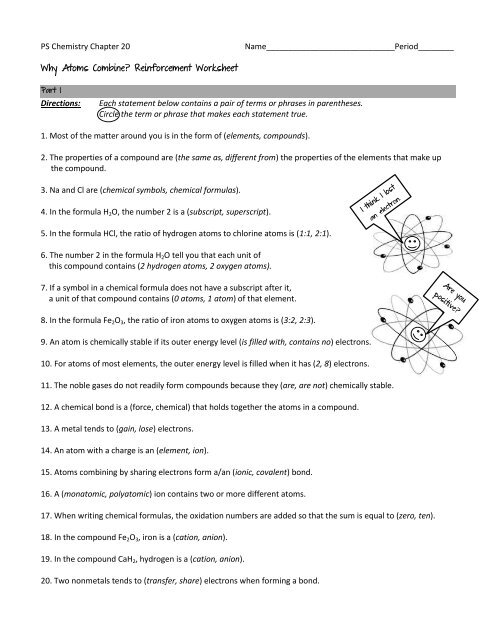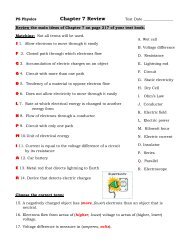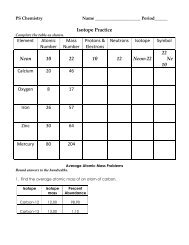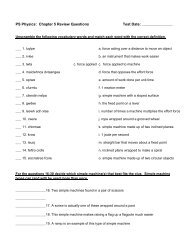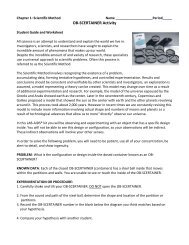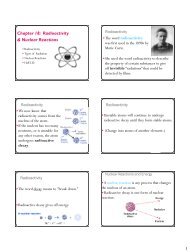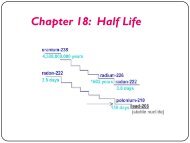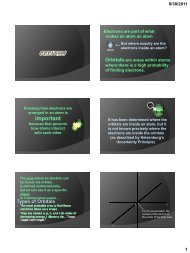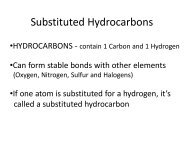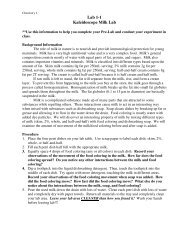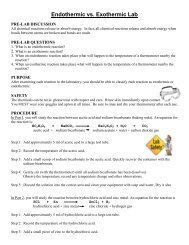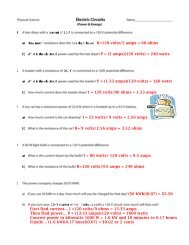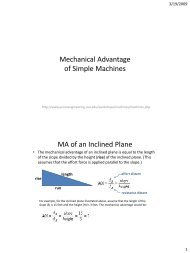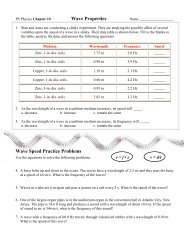Why Atoms Combine?
Why Atoms Combine?
Why Atoms Combine?
You also want an ePaper? Increase the reach of your titles
YUMPU automatically turns print PDFs into web optimized ePapers that Google loves.
PS Chemistry Chapter 20<br />
Name_____________________________Period________<br />
<strong>Why</strong> <strong>Atoms</strong> <strong>Combine</strong>? Reinforcement Worksheet<br />
Part 1<br />
Directions:<br />
Each statement below contains a pair of terms or phrases in parentheses.<br />
Circle the term or phrase that makes each statement true.<br />
1. Most of the matter around you is in the form of (elements, compounds).<br />
2. The properties of a compound are (the same as, different from) the properties of the elements that make up<br />
the compound.<br />
3. Na and Cl are (chemical symbols, chemical formulas).<br />
4. In the formula H 2 O, the number 2 is a (subscript, superscript).<br />
5. In the formula HCl, the ratio of hydrogen atoms to chlorine atoms is (1:1, 2:1).<br />
6. The number 2 in the formula H 2 O tell you that each unit of<br />
this compound contains (2 hydrogen atoms, 2 oxygen atoms).<br />
7. If a symbol in a chemical formula does not have a subscript after it,<br />
a unit of that compound contains (0 atoms, 1 atom) of that element.<br />
8. In the formula Fe 2 O 3 , the ratio of iron atoms to oxygen atoms is (3:2, 2:3).<br />
9. An atom is chemically stable if its outer energy level (is filled with, contains no) electrons.<br />
10. For atoms of most elements, the outer energy level is filled when it has (2, 8) electrons.<br />
11. The noble gases do not readily form compounds because they (are, are not) chemically stable.<br />
12. A chemical bond is a (force, chemical) that holds together the atoms in a compound.<br />
13. A metal tends to (gain, lose) electrons.<br />
14. An atom with a charge is an (element, ion).<br />
15. <strong>Atoms</strong> combining by sharing electrons form a/an (ionic, covalent) bond.<br />
16. A (monatomic, polyatomic) ion contains two or more different atoms.<br />
17. When writing chemical formulas, the oxidation numbers are added so that the sum is equal to (zero, ten).<br />
18. In the compound Fe 2 O 3 , iron is a (cation, anion).<br />
19. In the compound CaH 2 , hydrogen is a (cation, anion).<br />
20. Two nonmetals tends to (transfer, share) electrons when forming a bond.
Part 2<br />
Directions:<br />
Complete the table below by using the formula of each compound to identify the elements that<br />
each compound contains and the ratios of those elements.<br />
The first one has been done for you as an example.<br />
Formula Elements in compound Ratio<br />
H 2 O hydrogen, oxygen 2 : 1<br />
NaOH<br />
NH 3<br />
H 2 SO 4<br />
SiO 2<br />
Part 3<br />
Directions:<br />
Answer the questions about the diagram shown below.<br />
12p<br />
12n<br />
8p<br />
8n<br />
1. How many electrons will magnesium lose? ___________<br />
2. How many electrons will oxygen gain? ___________<br />
3. What will be the oxidation number of magnesium? ___________ Explain. ____________________________________<br />
________________________________________________________________________________________________________________________<br />
4. What will be the oxidation number of oxygen? ___________Explain. _________________________________________<br />
________________________________________________________________________________________________________________________<br />
5. What will be the total charge of the compound formed? ___________<br />
6. What type of bond will form? ___________________<br />
Part 4<br />
Directions:<br />
Below are two atoms and a compound they form.<br />
Based on the types of atoms, identify whether each set will form an ionic bond or a covalent bond.<br />
1. sodium and chlorine, NaCl ______________________________________<br />
2. gold and oxygen, AuO ______________________________________<br />
3. iron and oxygen, Fe 2 O 3 ______________________________________<br />
4. silicon and fluorine, SiF 4 ______________________________________<br />
5. hydrogen and oxygen, H 2 O ______________________________________


